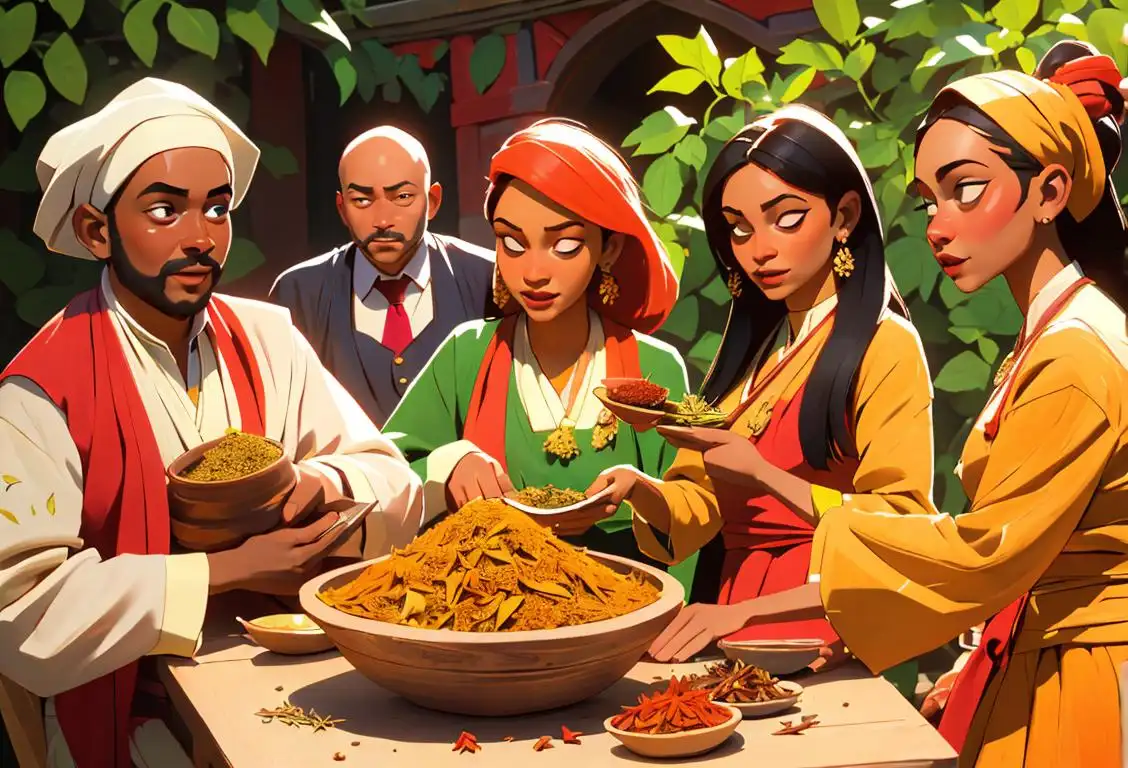National Herb And Spice Day

Welcome to National Herb and Spice Day! Are you ready to spice up your life and savor the flavors of the world? This delightful day celebrates the aromatic wonders of herbs and spices that add a special touch to our dishes. Get ready for a flavorful journey as we explore the internet history and fascinating facts about National Herb and Spice Day!
When is Herb And Spice Day?
It's national herb and spice day on the 10th June.
The Origin of National Herb and Spice Day
Do you ever wonder who came up with the idea of dedicating a day to herbs and spices? Well, the truth is, we couldn't trace an exact origin for this national day. But fret not, because just like the flavors they bring, herbs and spices have a rich and long history that spans across cultures and centuries.
The Internet Buzz
On June 10, 2015, the internet was abuzz with discussions and mentions about National Herb and Spice Day. People expressed their excitement and shared their favorite recipes featuring various herbs and spices. This day served as a reminder to explore new flavors and experiment in the kitchen.
A Flavorful Journey
Herbs and spices have been an integral part of human civilization for thousands of years. They add depth, fragrance, and complexity to our food, making each bite a tantalizing experience. From the pungent allure of garlic and onions to the earthy notes of cumin and turmeric, the world of herbs and spices is vast and diverse.
Throughout history, different cultures have used herbs and spices not only for flavor but also for their medicinal properties. Ancient civilizations believed in the healing powers of certain plants, and herbs were often used in traditional medicine practices.
Did You Know? In ancient Egypt, herbs and spices were not only used for cooking but also for embalming and preserving bodies. Talk about taking flavor to the afterlife!
Celebrate National Herb and Spice Day
On National Herb and Spice Day, let your taste buds embark on a flavorful adventure. Cook up a storm in the kitchen, experiment with new recipes, or recreate beloved family dishes with a twist. Dive into the world of exotic spices and discover their unique aromas.
Don't be afraid to get creative! Mix and match spices to create your own signature blends. Become the Master of Flavors and leave your guests craving for more.
Tags: loved ones, food, awareness, fun
History behind the term 'Herb And Spice'
5000 BCE
Early Discovery of Herbs and Spices
In 5000 BCE, ancient civilizations discovered the aromatic properties of herbs and spices. They began using various plants and plant parts for culinary, medicinal, and religious purposes. These early communities quickly realized the value of these natural ingredients and began cultivating and trading them among themselves.
3000 BCE
Early Beginnings
Herbs and spices have been used for thousands of years, with evidence of their use dating back to 3000 BCE. Ancient civilizations, such as the Egyptians, Greeks, and Romans, recognized the value of these flavorful and aromatic ingredients. They were primarily used for medicinal purposes, as well as for enhancing the taste of food.
3500 BCE
Ancient Beginnings
Herbs and spices have been used in culinary preparations since ancient times. The earliest evidence of their usage dates back to 3500 BCE in Egypt. The ancient Egyptians cultivated various herbs and spices like coriander, cinnamon, thyme, and saffron for their culinary and medicinal properties.
7000 BCE
Early Use of Herbs and Spices
The history of herbs and spices dates back to around 7000 BCE, when evidence suggests that ancient civilizations in Mesopotamia and Egypt were using various plants for culinary and medicinal purposes. These early civilizations recognized the flavor-enhancing and therapeutic properties of certain plants, paving the way for the widespread use of herbs and spices in the future.
1000 BCE
Ayurvedic Tradition
In ancient India, the Ayurvedic system of medicine emerged around 1000 BCE. Ayurveda recognized the therapeutic value of herbs and spices for improving health and wellbeing. Ayurvedic practitioners incorporated a wide range of herbs and spices into formulations, believing in their ability to balance the body and promote healing.
3500 BCE
Spices in Ancient Egypt
By 3500 BCE, the Egyptians had developed an intricate knowledge of herbs and spices. They used spices such as coriander, cumin, and fenugreek in their culinary preparations. Additionally, herbs like thyme and parsley were commonly used for medicinal purposes. The Egyptians also valued these aromatic ingredients in their religious rituals and embalming practices.
2700 BCE
Ancient Egyptian Influence
By 2700 BCE, the Ancient Egyptians had an extensive knowledge of herbs and spices. They used them not only for flavoring their food but also in religious rituals, cosmetics, and medicine. Famous herbs and spices of the time include cumin, coriander, garlic, and saffron.
2000 BCE
Trade and Exploration
Around 2000 BCE, the trade of herbs and spices began to flourish. The ancient Egyptians and Phoenicians were among the first to establish extensive trade routes to obtain valuable spices, such as cinnamon, pepper, and cardamom. These routes connected distant regions, allowing for cultural exchange and the spread of culinary knowledge.
1500 BCE
Ancient Chinese Herbal Medicine
Around 1500 BCE, the Chinese began developing an extensive system of herbal medicine. Traditional Chinese Medicine (TCM) utilized various herbs and spices as important components of healing treatments. This focus on the medicinal properties of herbs and spices greatly influenced the subsequent use of these ingredients in other regions of the world.
1000 BCE
The Spice Route
By 1000 BCE, the famous Spice Route had emerged, connecting the Eastern Mediterranean with the Far East. This complex network of land and sea routes facilitated the exchange of spices, herbs, and other commodities between Europe, Asia, and Africa. Valuable trade routes like the Silk Road and the Incense Route played a crucial role in the dissemination of knowledge and the creation of diverse cuisines.
Ancient Greece and Rome
Gastronomic Delights
Herbs and spices gained prominence in ancient Greece and Rome. The Greeks used herbs like oregano, thyme, and mint, while the Romans embraced spices like black pepper, cumin, and coriander. These flavorful ingredients became integral to their cuisines, enhancing the taste and aroma of dishes.
1200 BCE
The Spice Trade Begins
Around 1200 BCE, the spice trade began to flourish. Egyptians, Greeks, and Phoenicians were among the first to establish trade routes, allowing the exchange of herbs, spices, and other valuable goods across the Mediterranean region. This trade contributed to the spread of different culinary practices and cultural influences.
15th Century
Age of Exploration
The 15th century marked the beginning of the Age of Exploration, during which European explorers sought to discover new lands and trade routes. This era was instrumental in the expansion of the spice trade. Explorers like Christopher Columbus, Vasco da Gama, and Ferdinand Magellan ventured into unknown territories, seeking direct access to the rich sources of spices in India and the East Indies.
Medieval Times
The Spice Trade
During the Middle Ages, a thriving spice trade developed, spanning across continents. Spices like black pepper, cinnamon, nutmeg, and cloves were highly prized and sought after, resulting in the establishment of lucrative trade routes. The spice trade played a significant role in shaping the development of global commerce.
300 BCE
Greek and Roman Culinary Traditions
The ancient Greeks and Romans made significant contributions to the culinary use of herbs and spices. Greek physician Hippocrates emphasized the importance of herbs in maintaining health and treating illnesses, while Roman gastronomist Apicius compiled a comprehensive cookbook that showcased a wide range of herbal and spiced dishes. The popularity of these culinary practices spread throughout the Mediterranean region.
500 BCE
Herbs and Spices in Ancient Greece and Rome
In 500 BCE, Greece and Rome emerged as prominent hubs for herb and spice usage. The ancient Greeks, known for their love of flavors, embraced herbs such as dill, oregano, and thyme. Romans, meanwhile, incorporated spices like black pepper, cinnamon, and nutmeg into their recipes. These civilizations greatly influenced the subsequent use of herbs and spices in European cooking.
7th Century CE
Arab Traders and the Silk Road
During the 7th century CE, Arab traders played a crucial role in the global spice trade. They established the famous Silk Road, a network of trade routes connecting East and West, and facilitated the exchange of herbs, spices, and other commodities. The Arab traders introduced spices like cumin, cloves, and cardamom to Europe, leaving a lasting influence on the region's cuisine and culture.
18th Century
Colonialism and Culinary Fusion
In the 18th century, colonial powers established settlements and trading posts in various parts of the world to secure their control over spice-rich regions. This period of colonization not only influenced the political landscape but also brought about culinary fusion. The exchange of ingredients and cooking techniques led to the creation of unique dishes that fused the flavors and traditions of different cultures.
7th-13th Centuries
Islamic Golden Age and Spice Trade
During the Islamic Golden Age (7th-13th centuries), Arab traders played a crucial role in the spice trade. Spices such as pepper, cinnamon, cloves, and nutmeg were actively traded across long-distance routes, connecting Europe, Asia, and Africa. The demand for exotic spices not only enriched the Arab merchants but also sparked exploration and colonization by European powers in search of direct trade routes to these valuable commodities.
Age of Exploration
Explorers and New Discoveries
The Age of Exploration in the 15th and 16th centuries opened up new horizons for the discovery of herbs and spices. Explorers like Christopher Columbus, Vasco da Gama, and Ferdinand Magellan ventured into uncharted territories, seeking new sources of valuable spices. This era led to the discovery and introduction of various herbs and spices from different parts of the world.
Modern Times
Integration into Global Cuisines
In modern times, herbs and spices have become an integral part of global cuisines. From Indian curries featuring a blend of aromatic spices to Italian dishes enriched with basil and oregano, each culture has developed its own unique culinary traditions using herbs and spices. The popularity of international cuisine has further expanded the demand and appreciation for diverse flavors.
20th Century
Industrialization and Global Spice Market
The 20th century witnessed the industrialization of the spice trade. Advances in transportation and preservation techniques made it easier to transport and distribute herbs and spices to a wider market. The establishment of global spice companies and the growth of international trade allowed people from various cultures to access a wide range of herbs and spices, enriching their culinary experiences.
15th-17th Centuries
Age of Exploration and Spice Routes
The 15th to 17th centuries marked the Age of Exploration, during which European powers sought direct access to the Spice Islands (present-day Indonesia). This period saw renowned explorers like Christopher Columbus, Vasco da Gama, and Ferdinand Magellan undertaking perilous voyages to establish trade routes. The discovery and control of these lucrative spice routes fueled colonial expansion and transformed the global economy.
15th-17th Centuries
The Age of Exploration
The 15th to 17th centuries marked the Age of Exploration, during which European nations sought new routes to Asia and its abundant spice sources. This era witnessed famous voyages by explorers like Christopher Columbus, Vasco da Gama, and Ferdinand Magellan. The exploration not only expanded geographical knowledge but also led to the discovery of new spices, including chili peppers, vanilla, and allspice.
18th-19th Centuries
Industrial Revolution and Mass Production
The Industrial Revolution in the 18th and 19th centuries brought significant advancements in the processing and distribution of herbs and spices. Improved transportation, packaging, and preservation techniques enabled mass production and global trade. Companies like McCormick & Company emerged as pioneers in the industrialization of spice processing, making herbs and spices more accessible to a wider population.
18th-19th Centuries
Colonial Influence on Spice Trade
During the 18th and 19th centuries, European colonial powers exerted significant control over trade routes and sought to monopolize the spice trade. Britain, France, and the Netherlands established colonies in spice-rich regions like Southeast Asia, India, and the Caribbean. This influence not only reshaped the spice trade but also introduced new flavors and culinary traditions to European cuisines.
20th Century
Culinary Revolution and Fusion Cuisine
In the 20th century, the world experienced a culinary revolution, embracing diverse flavors and international cuisines. Chefs like Julia Child and Yotam Ottolenghi popularized the use of herbs and spices in Western cooking. Furthermore, the blending of various culinary traditions gave rise to fusion cuisine, where herbs and spices from different cultures are combined to create exciting new flavors.
20th Century
Commercialization and Global Availability
In the 20th century, advances in transportation, refrigeration, and globalization revolutionized the herb and spice industry. These developments allowed for mass production, storage, and transportation of herbs and spices, making them readily available worldwide. Today, people have access to a vast array of herbs and spices from different cultures, enriching culinary experiences and promoting cultural diversity.
Present Day
Continued Significance and Exploration
Herbs and spices continue to play a vital role in global cuisine, offering an array of flavors, aromas, and health benefits. With increasing interest in natural remedies and international cuisines, there is ongoing exploration of lesser-known herbs and spices from around the world. From ancient civilizations to the modern food industry, the journey of herbs and spices remains an integral part of human culture and culinary practices.
Did you know?
In ancient Egypt, herbs and spices were not only used for cooking but also for embalming and preserving bodies. Talk about taking flavor to the afterlife!Tagged
awareness food fun loved onesFirst identified
10th June 2015Most mentioned on
10th June 2015Total mentions
39Other days
Biscuit Day
Cheese Lovers Day
Cheese Pizza Day
Bacon Day
Agriculture Day
Pumpkin Day
Foundation Day
Medal Of Honor Day
Guac Day
Drink A Beer Day









